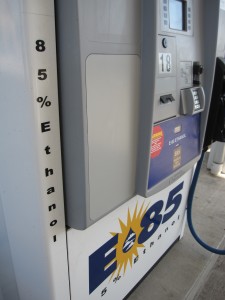Ethanol: A Great Option for Lowering Emissions
Illinois now has more than E85 fueling stations, more than any state in the country, according to the U.S. Department of Energy (DOE). More than 30 of the stations are located in Cook County. The City of Chicago operates approximately 7,000 vehicles, of which more than 2,000 are E85 flex-fuel vehicles.
Corn Ethanol Reduces Carbon Footprint, Greenhouse Gases
A study conducted by researchers at the U.S. Department of Energy’s (DOE) Argonne National Laboratory reveals that the use of corn ethanol is reducing the carbon footprint and diminishing greenhouse gases.

The study, recently published in Biofuels, Bioproducts and Biorefining, analyzes corn ethanol production in the United States from 2005 to 2019, when production more than quadrupled. Scientists assessed corn ethanol’s greenhouse gas (GHG) emission intensity (sometimes known as carbon intensity, or CI) during that period and found a 23% reduction in CI.
According to Argonne scientists, corn ethanol production increased over the period, from 1.6 to 15 billion gallons (6.1 to 57 billion liters). Supportive biofuel policies — such as the Environmental Protection Agency’s Renewable Fuel Standard and California’s Low-Carbon Fuel Standard — helped generate the increase. Both of those federal and state programs evaluate the life-cycle GHGemissions of fuel production pathways to calculate the benefits of using renewable fuels.
To assess emissions, scientists use a process called life-cycle analysis, or LCA — the standard method for comparing relative GHG emission impacts among different fuel production pathways.
“Since the late 1990s, LCA studies have demonstrated the GHG emission reduction benefits of corn ethanol as a gasoline alternative,” said Argonne senior scientist Michael Wang, who leads the Systems Assessment Center in the laboratory’s Energy Systems division and is one of the study’s principal investigators. “This new study shows the continuous downtrend of corn ethanol GHGemissions.”
“The corn ethanol production pathway — both in terms of corn farming and biorefineries — has evolved greatly since 2005,” said Argonne analyst Uisung Lee, first author of the study. Lee pointed out that the study relied on comprehensive statistics of corn farming from the U.S. Department of Agriculture and of corn ethanol production from industry benchmark data.
Hoyoung Kwon, a co-author, says that U.S. corn grain yields improved by 15%, reaching 168 bushels per acre despite fertilizer inputs remaining constant and resulting in a decreased intensity in fertilizer input per bushel of corn harvested: reductions of 7% in nitrogen use and 18% in potash use.
May Wu, another co-author, added that ethanol yields increased 6.5%, with a 24% reduction in ethanol plant energy use.
“With the increased total volume and the reduced CI values of corn ethanol between 2005 and 2019, corn ethanol has resulted in a total GHG reduction of more than 500 million tons between 2005 and 2019,” Wang said. “For the United States, biofuels like corn ethanol can play a critical role in reducing our carbon footprint.”
The Argonne team used Argonne’s GREET® model for this study. Argonne developed GREET (the Greenhouse gases, Regulated Emissions, and Energy use in Technologies) model, a one-of-a-kind LCA analytical tool that simulates the energy use and emissions output of various vehicle and fuel combinations. Government, industry, and other researchers worldwide use GREET® for LCA modeling of corn ethanol and other biofuels.
The work is funded by DOE’s Vehicle Technologies Office in the Office of Energy Efficiency and Renewable Energy.
Flex Fuel Vehicles

E85 fuel is composed of 85% ethanol alcohol and 15% gasoline. The gasoline ensures that the engine starts in cold weather, because pure alcohol will not start (in the winter, the blend is actually E70, or 70% ethanol and 30% gasoline). The ethanol in E85 comes from corn; most of the kernel is still available for use in traditional products such as animal feed. The Chevrolet Equinox, one of many General Motors’ vehicles that can run on E85, is flex-fuel capable.
Approximately 11 million flex-fuel vehicles on the road in North America can run on E85 fuel, a fact that is not widely known. In fact, a recent GM study found that roughly 70% of its flex fuel vehicle owners did not know that they could use E85 fuel, and fewer than 10% actually do use E85..
A flex-fuel vehicle can burn any combination of E85 and pure gasoline, so owners can fill up with either fuel at any time. Technically, a non-flex fuel model can be modified to run on E85, but it is not cost-effective.
E85 Fueling Stations
There are currently three fueling stations in Chicago for E85 flex-fuel vehicles.
On a national level, use of E85 is still not widespread. The highest concentration of filling stations is in corn-growing states such as Illinois, Iowa, and Minnesota. Overall, there are more than 2,000 E85 stations across 44 states, according to the DOE. The lowest availability of the fuel is in the South and the Northeast U.S., where it is difficult to produce ethanol locally.
Price Difference
At its current price per gallon, E85 does not save drivers money, and it might actually cost more. A gallon of E85 is approximately 15% less than the cost of a gallon of gasoline nationally, according to e85prices.com.
There are minimal implementation costs for the vehicles, although some vehicles are slightly more expensive to purchase.
Cost Comparisons
E85 produces 25% less energy per gallon than gasoline, so, on average, it ends up costing more.
For example, a flex-fuel Chevrolet Impala equipped with a 3.5-liter V6 engine gets an EPA-estimated 18/29 mpg (city/highway) on gasoline and 14/21 mpg when burning E85. The acceleration is roughly the same, but the range is shorter. In other words, the driver will be filling the tank more often when using E85.
In fact, E85 must be priced roughly 28% less than gasoline in order to break even. For example, if gasoline is $3 per gallon, the cost of E85 would need to be less than $2.16 per gallon. There are regions in the Corn Belt in which E85 reaches this threshold.



